
The average security dealer operates in a world where security is paramount and the customer is always right. But when you start to add fire and life safety systems into the mix, things can get complicated.
“This is a challenge for the security dealer and integrator because our business is not a code-driven one, it is a customer-mandated business,” says Tom Giannini, CPP, director of security and emergency communications marketing, Simplex Grinnell, Boca Raton, Fla. “Their reference points are based on whatever the customer wants. When you cross over and mix security and fire alarm and start creating an overall life safety solution, there are other considerations to ensure codes are not violated.”
The marriage of fire and security is not always a logical one, adds Shawn Mullen, chief energy officer, Protex Central Inc., Hastings, Neb.
“If you think about the logic of it, the rule of the fire alarm system is to facilitate the evacuation of a facility in the event of an emergency. It is designed to propel people to an exit. Then you add in this concept of access control, whose premise is to keep unauthorized people out of a building and it is an interesting intersection. The very doors typically designated for egress are the same doors designed and protected to keep people out of the building for ingress. There is an interesting dichotomy going on with those two systems.”
Add to that the fact that many security companies are not very experienced in the fire realm and things can get tricky. However, as more and more enterprise class systems require just that sort of integration, it is going to become increasingly common in the future for dealers and integrators to face this challenge at some point.
“Very few companies make the decision to become competent in both disciplines,” Giannini says. “But customers who have made an investment in all these different building systems don’t want all of them managed separately. It creates a huge management nightmare for them.
“The integrator is at a total disadvantage in this situation if they are strictly a security system integrator now being required to integrate fire alarms and emergency communications. They are not going to know what codes require and how to design a system successfully and cost effectively.”
What is Fire/Access Control Integration?
When it comes to combining fire/life safety systems with access control, what constitutes integration?
It can be as simple as a mechanical relay to a few doors or as complex as a fully integrated software-based system.
“Integration between two systems is fairly straightforward,” Mullen says. “A lot of times it is simply a mechanical relay. Some of the higher operating systems may do that over a software signal. But the majority of systems are just monitoring a relay for activation to cut the power supply. Typically those contacts are supervised by the fire alarm system.”
Bryan McLane, vice president, National Training Center, Las Vegas, agrees. “The integration is usually the simplest integration. But the fire alarm system has to have priority over the security system.
“The primary thing it is going to entail is the locking hardware interfaced to the fire alarm so that when the fire alarm goes off the doors unlock immediately. That is a code requirement for access control that actually appears in the fire codes.
Systems in the path of egress must unlock doors when fire alarms go off.”
Mullen adds: “At its very base the access control system is going to essentially lock or secure an ingress door so people can’t walk in without some type of credential. Already you are dealing with a locked mechanism. In a fire alarm, NFPA 72 requires that you have free, easy and open access out of a building, which means that from an interface standpoint you need to make sure if you are using magnetic locks that they de-energize. In other cases there may be turnstiles or gates. You need to make sure that those barriers are allowed to reverse or not be locked in order to allow people to egress. This requires the dealer to understand the mechanism being used and how it will allow people to get out in the event of a fire alarm.”
The higher level integration, of course, is more complex.
“For us, what integration means is full software integration between two distinct platforms,” Giannini says. “All fire points on the fire alarm system interface with the access control system and an event that appears on the fire alarm system will appear as the same type of event on the access control system. The major difference is that by code any acknowledgement or reset of the fire alarm must be done by the fire alarm panel.”
Even here, a very competent and technically experienced integrator can fall into the trap of simply installing the system to do what it was designed for. In fire and life safety, just because something is possible to do, that doesn’t mean it is allowed by the Authority Having Jurisdiction (AHJ) — the person, department or organization that has the final say at inspection time.
Common Pitfalls
Fire and safety codes are not standardized across city, state, county or nation. What is allowed in one jurisdiction might not be in the next, which makes for very complicated planning on the part of the integrator and not a few mix-ups.
“Hardly any of the cities here do everything exactly alike,” says Ray Cherry, vice president, Dallas Security Systems, Dallas. “Some will require pneumatic request-to-exit buttons, some don’t. Some require a request-to-exit motion detector, others don’t.”
Chris Venable, administrative vice president, DSS Fire (Dallas Security Systems’ sister company), Dallas, agrees.
“The biggest potential pitfall for the integrator is in the design aspect, not knowing the local authority’s specific requirements. We are usually hired by two completely separate entities and not all parties are always on the same page as far as who is designing what. If I don’t know whether a security contractor is designing a door strike or a magnetic lock it is hard for me to know what to design. Typically the security contractor is hired by the end user and I am hired through the general contractor. The more layers there are, the harder it is to get accurate information.
“For us the main times things don’t go smoothly are when it is a surprise to us that there is access control and we don’t find out until the last minute when our guys see the access guys at the site,” says Venable.
One of the most fraught situations is where magnetic locks with delayed egress are used. “You can have delayed egress according to code (provided the AHJ allows it), but it may be 15 or 30 seconds delay,” Giannini says. “Security would like the most time they can get in order to have time to send an officer. But the life safety wants the minimum.
“Some jurisdictions want to have a manual override on top of it, just in case the access control door doesn’t release as it should. So when you need to evacuate there is a separate pull station next to the access control door, painted a different color, that will disarm the power to the magnetic lock and open the door. We actually faced that situation when I was a corporate security director. We learned the hard way, and there was added expense associated with the additional feature the fire marshal wanted on the system.”
Mullen faced a different last-minute inspection issue. “We had a facility here where the designated egress door swung in instead of out. There was a reason for it, but it wasn’t caught in the review process, wasn’t caught in the permit process. Everyone went down the road until it came to the actual final for building acceptance and the fire marshal said, ‘What’s this?’”
They had designed a touch sense bar to release the door, which didn’t make much sense with the door swinging in. “It was an embarrassing moment and a hard fix because of the time compression involved. We had eight hours until the building was scheduled to open.”
Other issues can be more technical. “I have seen several, such as the supervision on fire alarm devices,” Mullen adds. “Sometimes the relay that controls the power supply for the fire alarm isn’t located according to standard. Sometimes the standby battery requirements are undersized, or not sized properly for the amount of alarm time required. Wire has to be sized properly for current loads.”
Working Together
Installations that go right often have the cooperation of the AHJ (and other involved parties) right from the start.
“One of the keys when doing this type of integrated solution is bringing in the AHJ in the design stage to get their input before you start expending dollars and doing the installation,” Giannini says. “The AJH is the final authority for the area. They control the implementation and interpretation of the codes. Systems today are very robust and designed to do a lot of things, but you have to really know the local market and the AHJ. Having an active dialog will prevent a lot of misperception and expense, instead of just saying ‘the product is designed to do that so I am going to go ahead and do it.’
“If you are a security company and your core competency is that and the customer wants integration between fire and access, before you commit to a design go out and find every AHJ that will be involved. Go over what that customer has requested and how you intend to do it. Keep them involved in the design process all the way and get them to sign off on it once they are satisfied.”
McLane agrees. “I hear horror stories all the time of people who have gotten cross-wise with the AJH. If you talk to them in advance they are usually pretty accommodating. But if you don’t, they are less willing to work with you after the fact. You are in their turf and didn’t ask their permission.”
But sometimes asking their permission requires you to find out whom to ask first. Like the codes themselves, the AHJ varies from place to place, and sometimes there is more than one.
“In one city it may be the fire marshal,” McLane says. “Another may be the building inspector or electrical inspector. It is an important effort on the part of the designer or installer to identify who this person is. Sometimes there is more than one and a lot of times they don’t agree. Usually the goal is to meet the higher, more stringent requirement.”
If you don’t know who your AHJ is, McLane recommends calling the local city or county offices or the state fire marshal.
Beyond the AHJ, as in any job, understanding the goals of the client will also help things go smoothly, Mullen adds. “What are the goals for security and fire alarm? Understand where there are potential conflicts between those goals, identify them early, then create your solution to avoid conflicts within those goals.”
Know the Code
It is always wise to work closely with the AHJ on any project that involves fire and life safety issues. But if you also have a working understanding of the codes upon which the AHJ bases their decisions, you will be ahead of the game.
The International Building Code, International Fire Code and National Fire Protection Association (NFPA) are good places to start.
“I usually order the next edition before cities around here start adopting it,” says Chris Venable, administrative vice president, DSS Fire. “If you know that base code that all amendments are based on, you can usually muddle your way through a lot easier.”
Below is a list of useful organizations and relevant codes:
• NFPA.org — NFPA72 (National Fire Alarm and Signaling Code, Edition 2010), NFPA 101 (National Life Safety Code)
• AFAA.org — Automatic Fire Alarm Association
• ESA.org — Electronic Security Association (formerly National Burglar and Fire Alarm Association)
• ICCSAFE.org — International Building Code, Section 10, International Fire Alarm Code









